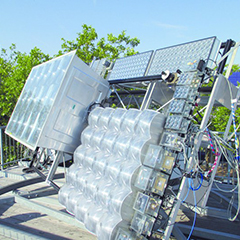Concentrator Photovoltaics (CPV) is a cost-effective method for generating electricity in regions that have a large fraction of direct solar radiation. With the help of lenses, sunlight is concentrated onto miniature, highly efficient multi-junction solar cells with efficiencies above 40 %. CPV modules are mounted on trackers that continually follow the sun’s path in order to use direct sunlight. Now, Fraunhofer ISE, together with NETRA, the research facility of the largest Indian public utility NTPC, are working together on a cooperative research project to determine the specific requirements needed for the use of CPV in India. The Indo-German research project “CPVIndia” is funded by the Kreditanstalt für Wiederaufbau KfW with resources from the German Federal Ministry for the Environment, Nature Conservation, Building and Nuclear Safety BMUB, as part of the international climate protection initiative.
The energy demand in India is large and growing fast. In order to meet this demand and at the same time develop the economy by climate-neutral means, the Indian government has declared the expansion of renewable energy in India as its goal. In this context, CPV is to be introduced as a research area in India and, in the medium term, established as a power plant technology.
“First of all, we want to achieve a transfer of knowledge especially in the area of CPV,” says Dr. Gerald Siefer, Team Leader of III-V Cell and Module Characterization at Fraunhofer ISE and Head of the Indo-German CPV project. Numerous seminars, given by the researchers from Freiburg, Germany, together with their Indian colleagues, are in the planning. “Another focus will be characterizing CPV technology in the context of the local climate conditions in India,” adds Siefer. For this purpose, four commercial CPV systems will be installed in India. These will be ordered in such a way so that comparative tests can be carried out, for example, to determine the effects of soiling on the energy performance. On the test field of its Indian partner, Fraunhofer ISE will install a tracker which can be used flexibly for measuring either CPV or other types of PV modules. With this tracker, special measurements can be carried out, for example, to investigate how different CPV modules react to misalignments. The information gained from these investigations is necessary for some of the evaluations carried out on the four CPV systems installed at the site.
In addition to the transfer of CPV know-how to the colleagues in India, the project will also provide the scientists with information on how to improve energy yield models for CPV. Relevant findings will be used as input for standards activities in the area of CPV, carried out by Working Group 7 of the Technical Committee 82 of the IEC (IEC TC82 WG7). The seminars and workshops will have an impact that reaches beyond the project participants themselves and are open to external participants who are interested in the topics covered.
“The ‘CPVIndia’ project not only enables bringing CPV technology to India, but also opens up several new avenues for joint collaboration with Fraunhofer ISE in various new areas” says Mr R K Srivastava, Executive Director, NETRA, NTPC Limited during his visit to the Institute. The German Aerospace Center (Deutsches Zentrum für Luft und Raumfahrt; DLR) is also involved in a sister project on the topic of solar thermal power production (CSP). Here a synergy effect could emerge, whereby the information gained about the required specifications for using concentrator technologies in India, could benefit both types of power plants (CPV and CSP).


























